
pc: pixabay.com
This week, we lit 212 trick candles for Frederick Chopin! Happy birthday to one of the most popular composers of the Romantic era. Here are nine pieces from our game that show his influence.
Franz Liszt (1811-1886) Six Chants Polonais de Chopin: My Darling Wagner, Debussy, Rimsky-Korsakov, Rachmaninoff, Schumann, Dvorak and Granados: these are just a few of the titans of classical music whose music shows Chopin’s influence. His sheer talent and stylistic innovations spread far beyond the borders of Poland (where he was raised to almost God-like status in arts circles,and every one of his pieces was transcribed for all instruments.) In Russia, Anatol Liadov was proclaimed the “Russian Chopin,” and in Norway, Edvard Grieg was nicknamed the “Chopin of the North.” Franz Liszt was perhaps the only contemporary composer who could match Chopin’s fame at the keyboard, and called the composer a close friend. The two lived only blocks away from each other in Paris, and on several occasions, between 1833 and 1841, gave concerts together. Liszt is responsible for popularizing six of Chopin’s nineteen art songs for voice, a collection that was completely outshined by Chopin’s many works for solo piano. Ironically, it was Liszt’s solo piano arrangements of these songs that brought about their rediscovery.
Robert Schumann (1810-1856) Carnaval, Op. 9: Chopin Robert Schumann’s Carnaval is a unique kind of composition. It’s a set of character pieces, where the different movements represent different “characters” at a masked carnival ball. Some of these characters are fictional, some imaginary, and some were real life people, including Schumann's wife Clara Schumann and Frederic Chopin. It’s also full of riddles. In fact, Schumann wrote to a friend: “deciphering my masked ball will be a real game for you.” The work is unified by a four-note motive — A, E-flat, C, and B — which occurs in various orders. These notes also function as a musical cryptogram, encoding the name of a German city, the German word for Carnival, and Schumann’s own name, depending on the order. The work was originally written for piano, however, as with many of Schumann’s works, it is well suited to orchestration, as we just heard.
Johann Schmelzer (c.1621-1680) Polish Bagpipes' in G Part of Chopin’s early appeal was how he worked his Polish identity into his style through the inclusion of folk elements, especially the mazurka. However, he was not the first composer to do so. Schmelzer was one of the leading musicians in Austria before Heinrich Biber, making significant contributions to the development of instrumental music, especially the violin sonata. He was widely regarded as one of the finest violinists in Europe, one of the few Austrians to gain such a reputation in a field that was dominated by Italian string players. He spent his entire musical career as a court violinist at the Habsburg court in Vienna where he composed and performed for Emperor Leopold, an avid patron of the arts. This piece is an example of one of the many chamberworks he composed for the Hapsburg court: a trio sonata for two violins and continuo imitating the Koziol or Polish bagpipes. Like the Scottish highland pipes, the Koziol are still very recognizable in Europe today for their distinctive look. The name translates to “white goat” because the pipe bag is traditionally made from a white goat hide. A goat head is often carved to ornament the chanter pipe and a goat horn helps amplify the sound
César Franck (1822-1890) Variations Symphoniques With a performance career spanning eight decades, Arthur Rubinstein is considered to be one of the greatest piano virtuosos of the 20th century. Born in Lodz, Poland, where he showed promise as a musician at age 3, he traveled to Warsaw and Berlin for most of his musical education. As he matured as a musician, he was quick to put aside formal piano studies and begin touring extensively in Europe and America. He also became a military interpreter in London during World War I, being fluent in eight languages. In 1946 he became an American citizen after several years of touring in the US and took up residence in Brentwood, California during World War II. He is most well known for his performances of Chopin and for recording the composer’s entire work.
Ignaz Joseph Pleyel (1757-1831) String Quartet in E-flat, Op. 2, No. 4 Ignaz Pleyel enjoyed enormous success as a composer due to the popularity of his compositions, and also due to the financial success of his music publishing house and piano making firm in Paris. Pleyel, along with fellow craftsman Jean Henri Pape, improved on English piano-making and introduced to France a new kind of upright piano known as the “pianino” or cottage piano. Chopin had a strong preference for Pleyel pianos and became their unofficial spokesperson when he made his Parisian debut at Pleyel’s concert venue. Chopin himself eventually owned a Pleyel grand from 1839 with a special light touch, and an additional upright piano for his students.
Leopold Godowsky (1870-1938) Eight Etudes For The Left Hand Alone by Chopin: No. 21 in A There is no doubt that Chopin’s etudes are considered a monument of musical virtuosity. Brilliantly difficult and masterfully written, these twenty-seven etudes blurred the line between “academic exercise” and “concert showpiece.” So why make them even more difficult? For virtuoso pianist Leopold Godowsky, the challenge just wasn’t enough. Godowsky took Chopin’s twenty-seven originals and rearranged them into 53 studies of the studies, thought to be the most difficult pieces ever written for the piano. In this particular study, Godowsky puts the entire thing in the left hand. In other etudes, he transfers right hand material to the left hand, while putting new material in the right, and transposes the key up a half-step. And yet in others, he combines two of Chopin’s etudes, one in the right hand, and another in the left.
Jósef Elsner (1769-1854) Sonata in F, Op. 10, No. 1 In his early education, Josef Elsner proved to be proficient both in violin and as a vocalist, and even started composing religious music. However, at the University of Breslau he decided to study theology and medicine. It wasn’t until he moved to Vienna in 1789 that he decided to completely switch to music, becoming a conductor and violinist in the opera orchestra at Lviv. He was very active as both a composer and teacher, eventually settling permanently in Warsaw where he mentored many famous musicians and composers including a young Chopin. Elsner’s music is considered to be the precursor of the Polish national style which Chopin would expand on. He combined Polish folk elements and dance forms with the predominant Viennese classical tradition, and was particularly interested in capturing the meter and intonation of the Polish language into classical music.
Karol Szymanowski (1882-1937) Mythes, Op. 30: La Fontaine d'Arethuse Championed by his fellow countrymen like Witold Lutoslawski, Polish composer Karol Szymanowski became the savior of Polish music in the early 20th century, following in the steps of Chopin. His works evoke the Romanticism of Chopin and Richard Strauss, the Impressionism of Claude Debussy, and the atonal experiments of Alexander Scriabin. Greek mythology also fascinated him, and he composed two separate works on mythological subjects in 1915. The chamber work Myths from that year for violin and piano is a triptych of three such tales: the subject of the first movement is the nymph Arethusa who was transformed into a fountain by the god Artemis; the second movement “Narcissus” is about that beautiful yet self-obsessed mythological figure. And the third movement, which evokes the music of Debussy and Roussel, is about the tree nymphs the Dryads and their companion god of the wild Pan.
Harry Carroll (1892-1962) I'm Always Chasing Rainbows This Tin-Pan Alley song was already popular on the vaudeville circuit when Judy Garland’s 1941 rendition in the musical film Ziegfeld Girl became an instant classic. “I’m Always Chasing Rainbows” was penned by Harry Carroll, with lyrics by Joseph McCarthy, though Carroll can’t take complete credit for the music, as the melody is actually adapted from Chopin’s Fantasie-Impromptu. The song was first a hit as early as 1918 when it was recorded by Charles W. Harrison for Victor Records and Harry Fox for Columbia Records that same year. The song has appeared in many other subsequent films and musicals and has been covered by countless artists including Perry Como, Julie Andrews, Bing Crosby, Sammy Davis Jr., and even Alice Cooper.








